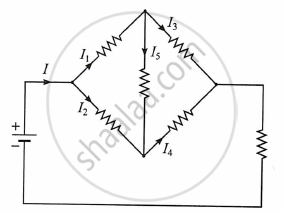Advertisements
Advertisements
Question
The measurement of an unknown resistance R is to be carried out using Wheatstones bridge (figure). Two students perform an experiment in two ways. The first students takes R2 = 10 Ω and R1 = 5 Ω. The other student takes R2 = 1000 Ω and R1 = 500 Ω. In the standard arm, both take R3 = 5 Ω. Both find R = `R_2/R_1 R_3` = 10 Ω within errors.
- The errors of measurement of the two students are the same.
- Errors of measurement do depend on the accuracy with which R2 and R1 can be measured.
- If the student uses large values of R2 and R1, the currents through the arms will be feeble. This will make determination of null point accurately more difficult.
- Wheatstone bridge is a very accurate instrument and has no errors of measurement.
Options
a and b
b and c
c and d
a and d
Solution
b and c
Explanation:
Wheatstone bridge: The bridge is an arrangement of four resistance which can be used to measure one of them in terms of rest. Here arms AB and BC are called ratio arm and arms AC and BD are called conjugate arms.
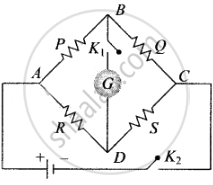
Balanced bridge: The bridge is said to be balanced when deflection in the galvanometer is zero, i.e. no current flows through the galvanometer or in other words VB = VD. In the balanced condition `P/Q = R/S`, on mutually changing the position of cell and galvanometer this condition will not change.
Unbalanced bridge: If the bridge is not balanced current will flow from D to B if VD > VB, i.e. (VA – VD) < (VA – VB) which gives PS > RQ.
According to the problem for first students, R2 = 10 Ω, R1 = 5 Ω, R3 = 5 Ω
For second student, R1 = 500 Ω, R2 = 1000 Ω, R3 = 5 Ω
Let us take R4 = R.
Now, according to the Wheatstone bridge rule,
`R_2/R_1 = R_4/R_3` ⇒ `R_4 = R_3 xx R_2/R_1`
Now putting all the values in above equation, we get R = 10 Ω for both students. Thus, we can analyse that the Wheatstone bridge is most sensitive and accurate if resistances are of the same value.
Thus, the errors of measurement of the two students depend on the accuracy and sensitivity of the bridge, which in turn depends on the accuracy with which R2 and R1 can be measured.
The currents through the arms of bridge is very weak when R2 and R1 are larger.
This can make the determination of null point accurately more difficult.
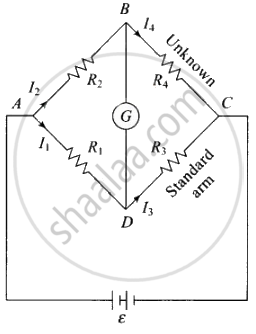
APPEARS IN
RELATED QUESTIONS
Four resistances 4Ω,8Ω,XΩ, and 6Ω are connected in a series so as to form Wheatstone’s
network. If the network is balanced, find the value of ‘X’.
Explain with a neat circuit diagram. How you will determine the unknown resistances using a meter bridge.
With resistances P and Q placed in the left and right gaps of a metre bridge, the balance point divides the wire in the ratio of 1/3. When P and Q are increased by 40 n each. the balance point divides the wire in the ratio of 3/5. The values of P and Q will be respectively, ______
In Wheatstone's bridge P = 7 ohm, Q = 12 ohm, R = 3 ohm and S = 8 ohm. How much resistance must be put in parallel to the resistance S to balance the bridge?
In the Wheatstone bridge, (shown in the figure) X = Y and A > B. The direction of the current between a and b will be ____________.
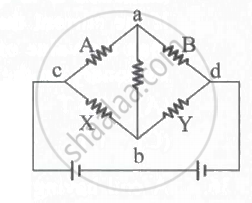
Which among the following resistances can be determined by a metre bridge?
The Wheatstone bridge is in a more balanced state when the ratio of arms P and Q is ______
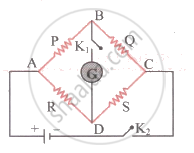
The figure below shows a balanced Wheatstone network. If it is disturbed by changing P to 22Ω, then which of the following steps will bring the bridge again to a balanced state?
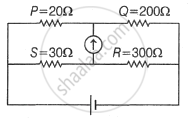
In the given circuit, if I = 100 mA and I1 = I4 = 60 mA, the currents I3 and I5 are ______.
